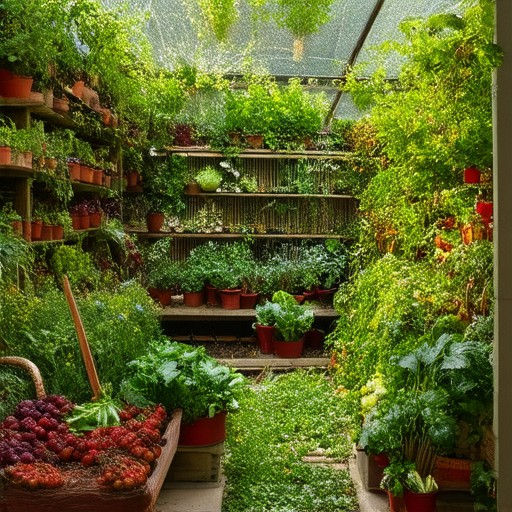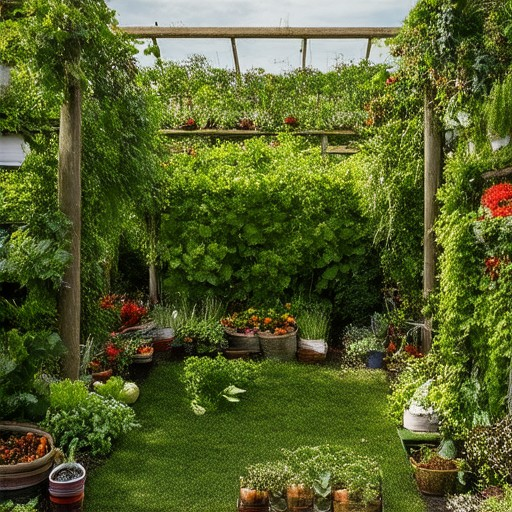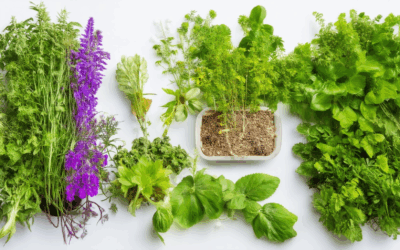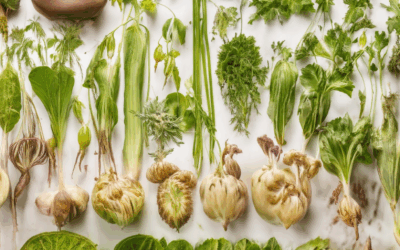Seasonal gardening offers a unique opportunity to cultivate crops that thrive in specific environments, and heirloom vegetables are no exception. These timeless plants, passed down through generations, possess distinct flavors, rich histories, and remarkable resilience. For gardeners seeking to maximize their yields while preserving tradition, mastering seasonal gardening with heirlooms becomes both an art and a science. This guide delves into strategies that align growing practices with the natural rhythms of your climate, ensuring bountiful harvests and a connection to agricultural heritage. From optimizing soil health to adapting techniques for different seasons, discover how seasonal gardening enhances the growth of heirloom vegetables, offering both sustenance and storytelling.
Key Takeaways
– Select seeds adapted to your climate for optimal growth and reliability.
– Amend soil thoroughly with organic matter to boost fertility and drainage.
– Adapt watering techniques to conserve water while maintaining consistent moisture.
– Protect plants during cooler months with cover crops or cold frames.
– Integrate companion planting and practice crop rotation for better pest control and soil health.
– Use mulch effectively to retain moisture, suppress weeds, and regulate soil temperature.
– Transplant seedlings timely to maximize growth and yield based on your region.
Effective Strategies for Growing Heirloom Vegetables with Seasonal Conditions
Growing heirloom vegetables requires understanding and adapting to seasonal conditions to maximize productivity and flavor. Here’s a comprehensive guide to effectively growing these timeless plants:
- Plan Ahead with Seed Selection
- Select heirloom seeds suited for your region and season.
- Choose varieties that thrive in your local climate and growing season.
- OldSeed offers a diverse range of heirloom seeds tailored for different regions, ensuring successful growth.
- Timing is Key
- Plant cool-season crops like lettuce and spinach in early spring.
- Sow warm-season vegetables such as tomatoes and peppers when temperatures rise.
- Transplant seedlings when the soil temperature reaches optimal levels for the specific crop.
- Adapt Soil Preparation
- Amend the soil with compost and manure to improve fertility and drainage.
- For clay soils, incorporate organic matter to enhance water infiltration and root growth.
- OldSeed provides detailed guides on soil preparation for various seasonal conditions.
- Adjust Watering Techniques
- Use drip irrigation during dry seasons to conserve water and maintain moisture.
- Ensure well-drained beds during wet periods to prevent waterlogging.
- Pest and Disease Management
- Monitor for common pests and diseases specific to each season.
- Implement integrated pest management (IPM) practices to control infestations.
- Companion planting can naturally deter pests and support healthy plant growth.
- Fertilize Appropriately
- Apply fertilizers at the correct times and in the right amounts based on the season.
- Consider the nutrient needs of heirloom varieties during different growth stages.
- OldSeed offers insights into seasonal fertilization schedules and ratios.
- Harvest at the Right Time
- Harvest vegetables when they reach peak ripeness for optimal flavor and yield.
- Follow OldSeed’s harvesting guides to ensure timely collection for each crop.
- Proper Storage
- Store harvested vegetables in root cellars or cool, dark places to extend freshness.
- Preserve herbs and soft fruits with OldSeed’s recommended storage methods.
- Crop Rotation
- Rotate crops to maintain soil health and prevent nutrient depletion.
- Follow OldSeed’s rotation guidelines to optimize heirloom growth.
By tailoring your approach to seasonal conditions and leveraging resources from OldSeed, you can successfully grow heirloom vegetables that thrive in your specific environment. Their extensive library of guides and tips ensures that your gardening efforts are both rewarding and sustainable.
Best Tips for Growing Heirloom Vegetables During Different Seasons
We’ve compiled expert advice to help you grow heirloom vegetables successfully throughout the year, tailored to each season’s unique conditions.
Spring Gardening Tips
- Prepare Soil Early: Test soil pH levels and amend with compost or organic matter to ensure optimal nutrient availability for spring crops.
- Choose the Right Crops: Heirloom tomatoes, peppers, and onions are ideal for warm-season planting but can be started indoors in late spring.
- Protect from Frost: Use cold frames or row covers to shield young plants from late spring frosts.
- Plan Rotation: Rotate crops to prevent pests and diseases, ensuring a balanced garden ecosystem.
Summer Growing Strategies
- Water Regularly: Heirloom vegetables require consistent moisture, especially during hot summers. Consider drip irrigation systems.
- Pollinator Support: Plant flowers to attract bees and butterflies, which aid in pollination for fruits and vegetables.
- Mulch Effectively: Apply organic mulch to retain soil moisture and suppress weeds, reducing the need for frequent watering.
- Protect from Pests: Integrate companion planting with herbs like basil and marigolds to deter pests organically.
Fall Harvesting Hints
- Extend the Growing Season: Use cool-weather crops like spinach, kale, and carrots to harvest in fall and winter months.
- Succession Planting: Replant quick-growth vegetables in empty spots left by harvested crops to maximize space and productivity.
- Preserve Harvested Vegetables: Store root vegetables like potatoes and carrots in sandboxes or cellars for winter storage.
- Compost Responsibly: Add fallen leaves and kitchen scraps to compost piles to enrich soil for next season’s planting.
Winter Care Tips
- Protect Plants: Cover heirloom vegetables with row covers or cold frames to protect against frost damage during winter.
- Prune Dead Growth: Remove diseased or damaged plants in late winter to promote healthy growth in the upcoming season.
- Start Indoors: Begin seedlings indoors in mid-winter for early spring planting, ensuring a head start on the growing season.
- Plan Seed Orders: Research and order heirloom seeds early to ensure availability for spring planting.
By adapting your gardening techniques to each season’s unique challenges, you can enjoy a bountiful harvest of heirloom vegetables throughout the year. Experiment with different varieties and techniques to discover what works best for your specific climate and soil conditions.
How to Successfully Grow Heirloom Vegetables in Alignment with Seasonal Conditions
Growing heirloom vegetables requires understanding the unique challenges and opportunities each season presents. By aligning your gardening efforts with seasonal conditions, you can maximize productivity, flavor, and yield. Here’s a comprehensive guide to achieving success:
Plan Your Planting Schedule
- Spring Planting:** Focus on cool-season crops like lettuce, spinach, and peas. Warm-season crops such as tomatoes, peppers, and beans can be started indoors in late spring for later transplantation.
- Summer Growing:** Optimize for heat-tolerant varieties like heirloom tomatoes, okra, and sweet potatoes. Regular watering and mulching are essential to sustain plant growth during hot weather.
- Fall Planting:** Prepare soil for cool-season crops such as kale, Brussels sprouts, and carrots. Fall is ideal for root vegetables and leafy greens.
- Winter Growing:** Overwinter crops like garlic, onions, and winter squash in regions with mild winters. Protect plants from frost with row covers or cold frames.
Select Varieties Based on Seasonality
- Spring and Summer Crops:** Choose fast-growing heirloom varieties like “Black Beauty” lettuce or “Golden Bantam” corn for quick harvests.
- Fall and Winter Crops:** Opt for hardy varieties such as “Kaleidoscope” kale or “Ruby Queen” beet for extended harvests.
- Region-Specific Choices:** Research local heirloom varieties suited for your climate to ensure optimal growth and flavor.
Prepare Soil Appropriately
- Amend Soil:** Incorporate organic matter like compost or aged manure to improve soil fertility and structure.
- Consider pH Levels:** Most heirloom vegetables thrive in slightly acidic to neutral soil (6.0–7.0 pH). Test your soil before planting.
- Organic Practices:** Use natural fertilizers and pesticides to maintain soil health and reduce chemical exposure.
Watering Strategies
- Consistent Moisture:** Heirloom plants require consistent watering, especially during germination and flowering stages.
- Drought-Tolerant Crops:** Some heirloom varieties are drought-resistant, such as “Burpee’s Golden Dwarf Cucumber.”
- Irrigation Systems:** Install drip irrigation or mulch to conserve water and prevent soil erosion.
Companion Planting
- Beneficial Insects:** Attract ladybugs and bees to control pests naturally.
- Repel Pests:** Use companion plants like marigolds to deter pests or basil to repel aphids.
- Support Systems:** Provide stakes or cages for tall crops like tomatoes and peppers to aid in structural support.
Harvesting at the Right Time
- Know When to Harvest:** Different crops ripen at varying times; harvest vegetables when they reach peak ripeness for maximum flavor.
- Handle Gently:** Avoid damaging plants during harvesting to ensure healthy growth of remaining crops.
- Store Properly:** Store harvested vegetables like potatoes and squash in cool, dry places to prevent spoilage.
By aligning your heirloom vegetable gardening with seasonal conditions and following these tips, you can enjoy bountiful harvests and richer flavors year-round. Explore our seasonal gardening resources for more insights and guides tailored to your growing needs.
Top Strategies for Growing Heirloom Vegetables Seasonally
- Choose Heirloom Seeds Suited to Your Climate: Select seeds that are adapted to your local growing conditions, including temperature ranges, rainfall patterns, and soil type. Resources like Old Seed’s seed selection guide offer tailored recommendations for different regions.
- Prepare Soil Thoroughly: Amend your soil with organic matter like compost or aged manure to improve fertility and drainage. For example, their soil preparation tools provide step-by-step instructions for optimal results.
- Adapt Watering Techniques: Heirloom plants may require more or less water depending on the season. Use drip irrigation or mulch to conserve water while maintaining consistent moisture levels. Learn more about efficient watering systems at Old Seed’s watering guide .
- Protect Plants During Cooler Months: Cover crops or cold frames can protect heirloom vegetables from frost damage during winter. Explore their crop protection techniques for additional insights.
- Companion Planting and Crop Rotation: Integrate vegetables with complementary plants to deter pests and improve soil health. Check out companion planting guides for successful integration.
- Use Mulch Effectively: Apply organic mulch like straw or wood chips to retain moisture, suppress weeds, and regulate soil temperature. Discover the best mulching practices at Old Seed’s mulching guide .
- Transplant Heirloom Starts Timely: Plant seedlings at the appropriate time for your region to maximize growth and yield. Refer to transplanting guides for specific timing advice.
Tools and Resources for Success
- Seed Banks and Suppliers: Trusted suppliers like Garden Fresh Seeds and Botanical Garden Supply offer high-quality heirloom seeds.
- Gardening Equipment: Invest in tools like their premium gardening tools for efficient planting and maintenance.
- Education and Support: Join online communities like Old Seed’s gardening forum for expert advice and shared experiences.
By implementing these strategies, you can successfully grow heirloom vegetables that thrive in your specific climate. Embrace the joy of sustainable gardening and savor the flavor of homegrown produce all season long!
Optimizing Heirloom Vegetable Growth Through Seasonal Considerations
To maximize heirloom vegetable growth, it’s essential to align your gardening efforts with seasonal factors. Here’s a comprehensive guide to optimizing your yields:
- Choose Varieties Suited to Your Climate: Select heirloom vegetables that thrive in your local environment. For example, tomatoes are ideal for warmer climates, while cool-season crops like spinach perform well in cooler temperatures.
- Plan Planting Times Based on Maturity Periods: Knowing when each heirloom variety reaches maturity helps in scheduling plantings. For instance, peppers and eggplants require longer growing seasons and should be started indoors before the last frost date.
- Adjust Watering and Fertilization: Different heirloom vegetables have distinct water and nutrient requirements. Regular monitoring of soil moisture and applying compost or organic fertilizers can promote healthy growth.
- Protect Against Pests and Diseases: Heirloom plants may be more susceptible to pests and diseases compared to hybrid varieties. Implement crop rotation, companion planting, and organic controls like neem oil to maintain plant health.
- Utilize Mulch for Soil Health: Applying mulch retains soil moisture, suppresses weeds, and regulates soil temperature. Choose the type of mulch that best suits your climate and gardening conditions.
- Harvest at Optimal Times: Each heirloom variety has a specific harvest window. Proper timing ensures maximum flavor and yield, whether you’re preserving through canning or fresh consumption.
By thoughtfully considering seasonal factors and tailoring your gardening practices, you can ensure heirloom vegetables thrive in your garden. Visit our Seasonal Gardening Guide for more insights and tips tailored to your regional climate.
Best Tips for Growing Heirloom Vegetables During Different Seasons
Growing heirloom vegetables requires attention to seasonal changes and adapting techniques to maximize productivity and flavor. Here are expert-recommended tips for each season:
- Spring: Start seeds indoors 6-8 weeks before the last frost date. Choose cold-hardy varieties like spinach or kale for early spring harvests. Prepare soil with compost and protect young plants from frost.
- Summer: Plant heat-tolerant heirlooms such as tomatoes, peppers, and eggplant. Water regularly to prevent stress from high temperatures. Provide shade for light-sensitive plants like spinach.
- Fall: Succession plant crops like lettuce, Swiss chard, and radishes in the same spot after harvested summer crops. Protect root vegetables like carrots and beets from frost by mulching heavily.
- Winter: Grow cold-hardy greens like kale, collards, and Brussels sprouts. Use row covers or cold frames to protect plants from frost damage. Plan next season’s garden by saving seeds from favorite heirlooms.
By adjusting your gardening strategy to each season’s unique challenges, you can enjoy a bountiful harvest of nutrient-dense, heirloom vegetables all year round. Visit our Seasonal Gardening Guide for more tips and resources to get started!








0 Comments